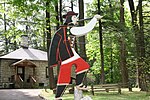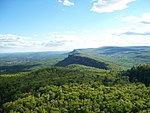Minnewaska State Park Preserve

The Minnewaska State Park Preserve is a 22,275-acre (90.14 km2) preserve located on the Shawangunk Ridge in Ulster County, New York on US 44/NY 55, five miles (8.0 km) west of New York State Route 299. The park, which features scenic overlooks of the nearby Catskill Mountains, is primarily used for picnicking, hiking, mountain biking, snowshoeing and swimming. The park is managed by the Palisades Interstate Park Commission and the New York State Office of Parks, Recreation and Historic Preservation. Four of the five sky lakes on the Shawangunk Ridge lie within the preserve: Lake Minnewaska, Lake Awosting, Mud Pond (also known as Lake Haseco), and Lake Maratanza; Mohonk Lake is on the property of the Mohonk Mountain House to the north of Minnewaska. Lake Minnewaska is a bit less than one-half mile (0.8 km) long by one-eighth mile (0.2 km) wide at its widest point. Lake Awosting is roughly three times as large, with a length of about one and an eighth miles (1.8 km) and a maximum width of about one-quarter mile (0.4 km) mile.
Excerpt from the Wikipedia article Minnewaska State Park Preserve (License: CC BY-SA 3.0, Authors, Images).Minnewaska State Park Preserve
Jenny Lane Trail (Blue), Town of Rochester
Geographical coordinates (GPS) Address Nearby Places Show on map
Geographical coordinates (GPS)
| Latitude | Longitude |
|---|---|
| N 41.72 ° | E -74.284 ° |
Address
Jenny Lane Trail (Blue)
Jenny Lane Trail (Blue)
Town of Rochester
New York, United States
Open on Google Maps








